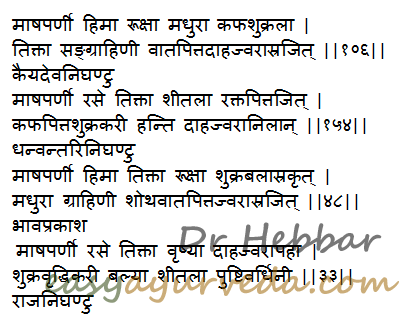Mashaparni – Teramnus labialis Uses, Dose, Research
Mashaparni – Teramnus labialis is highly nutrition rich Ayurvedic medicine, used for treating fatigue, muscle wasting, Vata and Pitta imbalance disorders, bleeding disorders etc.
Botanical name- Teramnus labialis (L.) Spreng.
Family- Fabaceae (Simbi kula / Aparajita upakula)
Table of Contents
Vernacular names
Names in different languages:
Hindi name- Vana Udad
Telugu name- Adavi Mahasaha
Sanskrit synonyms
Shurpaparni, Suryaparni, Pandura, Pandulomashaparni, Hayapucchika, Hamsamaya, Swadumaya, Mamsamasha, Mahasaha, Kambojika, Kamboji, Krushnavrunta, Simhavinna, Pishachika, Visarini
Ardramasha – quite similar to black gram in qualities
Mangalya, Kalyani – Auspicious
Kamboji – Common in cambodia
Mahasaha – Mashaparni can grow in any area
Hayapucchi – Leaves resembling horse tail
Chemical composition
Teramnus labialis chemical composition:
Seeds contain potassium, magnesium, calcium, and phosphorus Crude protein, crude fat, ash, and nitrogen free extracts constituted 22.86%, 6.10%, 4.62%, and 58.15%, respectively, of the seed weight. Caloric value of 100 g dry matter of seed material was 378.94 kcal. The essential amino acids lysine, leucine +isoleucine, arginine, valine and histidine were present in relatively large quantities. The unsaturated fatty acids constituted more than 60% of the crude fat. Antinutritional factors such as total free phenols, tannins, L-DOPA, hydrogen cyanide and phytic acid were present in minute quantities. These antinutritional factors are potentially eliminated using the conventional method of soaking the seeds in water,boiling with water and decanting prior to consumption(source)
Classical categorization
Masaparni – Classical Categorisation
Charaka-
Jivaniya – enlivening group of herbs
Shukrajanana – herbs helping in production of sperms
Madhura skandha – sweet tasting group of herbs
Sushruta- Kakolyadi, Vidarigandhadi
Vagbhata– Sukrajanana, Vidarigandhadi
Kaiyadeva Nighantu – Oshadhi Varga, Madhyama Panchamoola – Mudgaparni, Mashaparni, Bala, Punarnava, Eranda – Balances Kapha and Vata Dosha
Bhavaprakasha, Raja Nighantu, Dhanvantari Nighantu – Guduchyadi Varga
Shurpaparni dwaya – Mudgaparni and Masparni.
Properties, part used, dosage
Teramnus labialis medicinal Properties:
Guna- Laghu, Snigdha
Rasa (taste) – Madhura – sweet, Tikta – bitter
Vipaka- Madhura – sweet
Veerya – Sheeta – Coolant
Effect on Tridosha – Balances Vata and Pitta Dosha, increases Kapha Dosha
Part used- Root, Whole Plant
Dosage-Decoction 50-100 ml; powder 3-6 g
Sanskrit verse

Uses, indications
Teramnus labialis uses:
Shukrala – improves sperm and semen quantity and quality
Vrushya – aphrodisiac, improves vigor
Sangrahi – absorbent, useful in diarrhea, IBS
Asrajit – useful in blood disorders such as abscess, skin disorders, bleeding disorders such as menorrhagia, nasal bleeding etc.
Pushtivardhini – nutritious, improves nourishment
Indicated in:
Daha – burning sensation, as in gastritis, neuropathy, burning sensation in eyes etc
Jwara – fever
Raktapitta –Bleeding disorders such as nasal bleeding, heavy periods, etc
Shotha – Swelling, inflammation
Interaction with medicines, supplements
Can this be used while taking Homeopathic medicine?
Yes. This product does not react with homeopathic medicine.
Can this medicine be continued while taking supplements like multivitamin tablets, Omega 3 fatty acids etc?
Yes. Generally, this product goes well with most dietary supplements. However, if you are taking more than one product per day, please consult your doctor for an opinion.
With western
medicines
Seek your
doctor’s advice if you are taking this product along with other western
(allopathic / modern) medicines. Some Ayurvedic herbs can interact with modern
medicine.
If both Ayurvedic and allopathic medicines are advised together, then it is
best to take Allopathic medicine first, wait for 30 minutes and then take the
Ayurvedic medicine.
Ayurvedic medicines
Ayurvedic medicines with Mashparni as ingredient:
(click on the medicine names to know more about them)
Narayan oil and Mahanarayan oil – used for treating osteoarthritis, paralysis, myalgia etc.
Dhanwantharam Thailam – used in the treatment of Vata diseases such as Rheumatoid and osteoarthritis, spondylosis, headache and neuro-muscular conditions.
Vidaryadi Kashayam– used in respiratory conditions.
Dhanwanthararishtam –used in the treatment of low digestion power, low back ache.
Ajamamsa Rasayanam – used in treatment of Vata disorders like loss of strength, hemiplegia etc.
Amruth Jeevan Rasayan – used in treatment of fatigue, low immune power etc
Use as food:
Seeds of Mashaparni are used as food in some parts of Kerala and Salem District of Tamil Nadu.
Research
Antioxidant property: Department of Pharmacy, Annamalai University, Tamil Nadu conducted research on Free Radical Scavenging Activity of Methanolic Extracts of Whole Plant of Teramnus labialis. In vitro antioxidant activities were investigated. FRAP method and Estimation of total phenol, Nitric oxide methods were adopted. The results showed significant antioxidant activity when compare to the standard.
Antihyperglycemic activity study was conducted by Shaman Pharmaceuticals, South San Francisco. In vivo bioassay-guided fractionation of the aqueous alcohol extract of the aerial parts of Teramnus labialis (Roxb.) Benth. (Fabaceae), using C57BL/Ks-db/db mice as a model for type 2 diabetes, yielded an active fraction containing a mixture of coumarins. The major coumarin present in the active fraction was identified as fraxidin.
Anti inflammatory activity Bioassay-guided fractionation, based on anti-inflammatory activity of the methanolic extract of Teramnus labialis led to the isolation and characterization of vitexin, bergenin, daidzin and 3-O-methyl-D- chiro -inositol as active constituents. Vitexin exhibited a dose-dependent inhibitory activity on 5-lipoxygenase enzyme. The isolated constituents were also screened for their antioxidant activity by nitroblue tetrazolium (NBT) riboflavin photo reduction method. Vitexin exhibited moderate antioxidant activity. This is the first reported occurrence of vitexin, bergenin, daidzin and 3-O-methyl-D- chiro -inositol in T. labialis.
Morphology
Twinning herb with slender stem
Leaves- Compound, leaflets are membranous, glabrous above and hairy beneath
Inflorescence – Few flowered axillary racemes
Flowers – Papilionaceous, reddish coloured
Fruits- Pods hairy when young
Seeds – Rounded at the ends and dark brown in colour
Sustitute
Phaseolus calcaratus
Phaseolus sublobatus
Phaseolus dalelli
Atylosia goensis
Teramnus mollis
Adulterant
Puerasia phaseoloses
Calapugonium mucunoides
Sthanika Karma (Systemic Action)
Internal administration-
Digestive System – Carminative, Absorbent, Unctuous, facilitates proper movement of doshas. Indicated in abdominal distension, Malabsorption syndrome, Colic pain etc.
Circulatory system – Acts as a blood purifier, indicated in bleeding disorders, oedema etc.
Reproductive system – Aphrodisiac
Satmikarana – Indicated in general debility. (Jivaniya)
Tapakrama – indicated in fever, burning sensation










